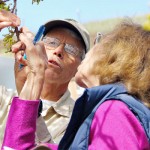Can a status update from a tulip tell us anything about climate change?
The science of seasonal observation has always mattered, but never has it been so urgent. Each year, our seasons unfold. Perhaps they feel the same to us each time, or maybe we notice the slight differences. A lack of rain in the west, and a barrage of snow in the east. Flowers are blooming earlier, fruit is ripening sooner. OK, so what’s the big deal with some slightly confused flora? Well, that confusion ripples outward, and that matters because of how beholden all living things are to other living things. The timing of our ecosystem, complicated as it is in the most ideal of times, is off-kilter.
The California Phenology Project, a collaboration between UC Santa Barbara, the National Park Service, and The National Phenology Network endeavors to document plant ranges, flowering dates, and other relevant data to assess climate change responses throughout the state of California. In the UC Natural Reserve System there are 3,300 plant species. The list reads like a poem of plants you may have never heard of: Awned Fescue, Ripgut Grass, Winecup Clarkia. The idea is that when these plants bloom within the season (and how that differs year to year) is actually a clue, indicative of the world they are blossoming into.
The phenological observations of scientists and citizens alike will all contribute to the Pheonology Project’s online resource, Nature’s Notebook, a kind of Facebook for Nature (I would totally friend request the California Poppy, golden and archetypal as it is, and Winecup Clarkia too, in all its hot pink, magenta splendor). But unlike the existential quandaries posed by the ubiquitous social media site, this online notebook will begin to reveal some of the patterns of our natural world and what that might mean for us. Since the task at hand is too large for just the professional scientists, now is the chance for people to reconnect with their environment and become contributors to this project, citizen-scientists observing and noting the plant species in Golden Gate Park or in their own backyard. We are all capable of phenological observation. The California Poppy accepts your friendship request! What will you do now?

